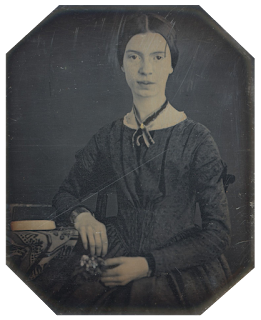Scarcely
could we have been acquainted with such dissimilar poems as the two consigned
to scrutinize; My life had stood-a loaded
gun by Emily Dickinson and Song of Myself
by Walt Whitman with regards to imagery, albeit these two authors achieve
what they want plus both represent modernity. Walt Whitman vs Emily Dickinson
Walt Whitman vs Emily Dickinson
Barring the
extension of both poems (Song of Myself is
a great deal longer than My life had
stood-a loaded gun) these two pieces of art, are different likewise in
every imagery aspect we might think of.
Walt Whitman
Whilst the poem by Whitman epitomizes imagery in all its splendour, allowing the reader to elaborate a vivid mental picture of everything conveyed.
Without going any further, we have these examples “Observing a spear of summer grass” (line 5), “the flog of my disposition” (line 16) or “the handkerchief of the Lord” (line 17). Similarly, “the young fellow drives the express wagon” (line 69) or “This grass is very dark to be from the white heads of old mothers” (Line 31), the aforementioned, works as literal language appealing to our senses, the poetic voice is evident therein.
On the other hand, Emily Dickinson pens a poem embracing a technique known as “Omitted centre”. The imagery on this poem is not as clear or as evident as the imagery in the poem by Whitman.
Emily Dickinson
Phrases such
as; “We roam in sovereign woods”
(line 5) “I guard My Master´s head”
(line 14), “On whom I lay a Yellow Eyes”
(line 19) can leave us both speechless and frustrated.
What
Dickinson leaves is open to interpretation. So open that the crucial
information is omitted in purpose, thus the meaning is not evident, it is
abstract. Indeed, there are discussions about what this poem in reality means
to date. Furthermore, while Dickinson is famous for her economy in language,
Whitman is because of his verbose poems.
Poetic voice
of Dickinson is unclear as her life was. By contrast, Whitman does make his
voice evident; this is a big difference amongst them. Howbeit, we ought to
point out that these both authors broke from previous ones in the sense they
paved the way for modern literature, being afar from religious themes that were
extremely popular in the past.
In
accordance with the imagery concept, the only thing both authors can be compared
to is they attain their aim and they are less close to God than what was
recurrent.
Notwithstanding, these two writers provide us with two utterly
different uses of imagery; Whitman uses it clearly to explain his feelings.
Conversely, Dickinson uses it to make the poem ambiguous. Walt Whitman vs Emily Dickinson



